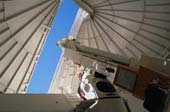Solar power Stations
The Seti Observatory will obtain all of it's electrical power from the Sun. We will be generating our electricity using "state of the art" Solar Panels and electronics.
Two separate, independent power supplies are to be constructed at the
site to provide a total of about 13kw electricity. The two power
stations will be almost identical to each other making the design phase
a lot easier than having to do two designs and then having more
maintenance issues to contend with.
 We are in the process of installing a
our second 6kw (kilowatt) solar power station that will provide all of our electrical needs for the foreseeable future. The main source of power for our activities will come from the Sun (Sol).
The picture at right is linked to the SOHO website. Just click on
the image of the sun for a current update on what's happening on our
nearest star, the SUN. We are in the process of installing a
our second 6kw (kilowatt) solar power station that will provide all of our electrical needs for the foreseeable future. The main source of power for our activities will come from the Sun (Sol).
The picture at right is linked to the SOHO website. Just click on
the image of the sun for a current update on what's happening on our
nearest star, the SUN.
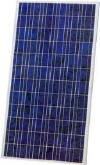 Basically,
the sun produces both heat and light, but we are mainly interested
in the visible light wavelengths because it is this part of the
spectrum that is used to produce electricity in the Solar Panels. We
have selected Solar Panels manufactured by
KYOCERA Solar as they are manufactured to a high standard and have very good specifications and other attributes that make them more popular with solar power systems designers & installers.
Just click on the solar panel at left for some full specs. Basically,
the sun produces both heat and light, but we are mainly interested
in the visible light wavelengths because it is this part of the
spectrum that is used to produce electricity in the Solar Panels. We
have selected Solar Panels manufactured by
KYOCERA Solar as they are manufactured to a high standard and have very good specifications and other attributes that make them more popular with solar power systems designers & installers.
Just click on the solar panel at left for some full specs.  The panels
have been installed on specially constructed frames that will provide support for an array of twelve (12) panels
for solar power station no1 (sp1) and 24 panels for solar power station
no2 (sp2). Each panel provides 165 watts of electricity giving us a total power input to the system of 1980 kilowatt hours
(ps1) and 3000 Kilowatt Hrs (ps2). We won't go into the full technical here, but if you want more information a very good article is on line that explains the technical aspects of solar power generation. The mounting frames were constructed on site by our team of volunteers who labour at the site almost every weekend. The panels
have been installed on specially constructed frames that will provide support for an array of twelve (12) panels
for solar power station no1 (sp1) and 24 panels for solar power station
no2 (sp2). Each panel provides 165 watts of electricity giving us a total power input to the system of 1980 kilowatt hours
(ps1) and 3000 Kilowatt Hrs (ps2). We won't go into the full technical here, but if you want more information a very good article is on line that explains the technical aspects of solar power generation. The mounting frames were constructed on site by our team of volunteers who labour at the site almost every weekend.
 Electric Power from the Solar Panels , 48 volts D.C. is fed underground to specially constructed buildings located 15m away next to one of our accommodation modules. Inside the buildings are the battery banks, D.C. charging regulators, power inverter and notebook computer that will be used to monitor the operation of all facets of the power stations. Electric Power from the Solar Panels , 48 volts D.C. is fed underground to specially constructed buildings located 15m away next to one of our accommodation modules. Inside the buildings are the battery banks, D.C. charging regulators, power inverter and notebook computer that will be used to monitor the operation of all facets of the power stations.
The batteries are Hawker tm series (above picture) supplied by
ENERSYS- HAWKER . We have 8 banks of 3 batteries arranged in a configuration that provides 48 volts to the inverter. The batteries are charged through a PL60 intelligent regulator supplied by Plasmatronics . The 240v alternating current (A. C.) is created by the power inverter manufactured by Power Solutions Australia who are a division of Selectronic Australia . The inverter is a model RAP48-5 and is shown here at left. This unit really is the heart of the power station as it provides all of our A. C. electricity needs for the observatory and the caretakers residence. HAWKER . We have 8 banks of 3 batteries arranged in a configuration that provides 48 volts to the inverter. The batteries are charged through a PL60 intelligent regulator supplied by Plasmatronics . The 240v alternating current (A. C.) is created by the power inverter manufactured by Power Solutions Australia who are a division of Selectronic Australia . The inverter is a model RAP48-5 and is shown here at left. This unit really is the heart of the power station as it provides all of our A. C. electricity needs for the observatory and the caretakers residence.
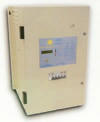 Hot water is one of those creature comforts that is great to have pouring over you after a hot, hard days work building the observatory. We have been supplied with a Solahart solar hot water system . This system
is mounted on top of our amenities building and provides an almost unlimited supply of hot water absolutely free from the heat of the sun. Hot water is one of those creature comforts that is great to have pouring over you after a hot, hard days work building the observatory. We have been supplied with a Solahart solar hot water system . This system
is mounted on top of our amenities building and provides an almost unlimited supply of hot water absolutely free from the heat of the sun.
 In the early stages of the observatories design, it was thought that we could tap into the local area's electricity power grid as there was a 3 phase connection point about 500m down the road. When we enquired as to the cost of this connection, which consisted of about 6 power poles and a 3 phase transformer we were flabbergasted to learn that it would cost us about $40k !!! This put a real spanner in the works as we had not considered that we would be up for such a huge cost and this alone nearly stopped the project in it's tracks. Luckily for us, the Australian Federal Government provided us with a partial solution for the
funding of a Solar Power Station . So, together with the above sponsors and some money through the Environmental Protection Agency we were able to build our observatory and obtain all of our power from the sun In the early stages of the observatories design, it was thought that we could tap into the local area's electricity power grid as there was a 3 phase connection point about 500m down the road. When we enquired as to the cost of this connection, which consisted of about 6 power poles and a 3 phase transformer we were flabbergasted to learn that it would cost us about $40k !!! This put a real spanner in the works as we had not considered that we would be up for such a huge cost and this alone nearly stopped the project in it's tracks. Luckily for us, the Australian Federal Government provided us with a partial solution for the
funding of a Solar Power Station . So, together with the above sponsors and some money through the Environmental Protection Agency we were able to build our observatory and obtain all of our power from the sun
The Diagram below shows a typical "RAPS" configuration.
(graphic below courtesy of Qld Govt EPA web site)
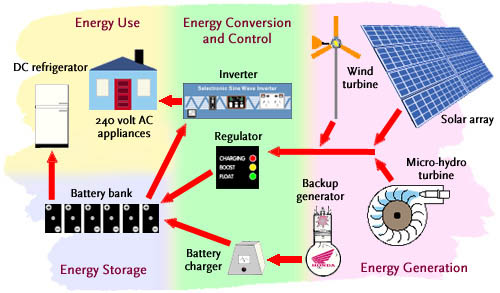
Below you will find data on
our solar power stations
 
POWER
STATION NO1
Well, the installation of the power station (sp1) finally got underway on Friday 27 June 2003. The power station building empty and without walls can be seen at right. Left shows the battery banks being unloaded and positioned ready for un packing. At left (bottom) the installed battery bank is in position ready for the building to be completed. Our usual line-up of helpers were there for the installation of the batteries which are crucial for the success of the whole project, Mike, Ron, David and Noel. The work has been carried out by our technical team and supported by some of our local volunteers. We are indeed very luck to have the support of helpers who come to the site to assist with the construction project.

 Sunelec
Pty Ltd are the successful contractors to supply the solar power station. History in the making, the first Sharp Solar panel is installed onto the frame (left). Klaus Coia and his assistant Tim start the installation of the Solar panels. At right the array is completed and ready to supply power to the batteries and ultimately the inverter. Sunelec
Pty Ltd are the successful contractors to supply the solar power station. History in the making, the first Sharp Solar panel is installed onto the frame (left). Klaus Coia and his assistant Tim start the installation of the Solar panels. At right the array is completed and ready to supply power to the batteries and ultimately the inverter.
 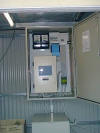 At left is Klaus Coia and Tim Ball who spent three days on site installing our power station. We had had about 30mm of rain the day before and on the first day of the installation. Mud was a real problem as you can see in some of the photos. At right is the heart of the power station. The main unit is the PSA 5kw Inverter. This unit converts the 48v DC from the batteries to AC 240v which is the normal mains voltage in Australia. the blue unit above and to the right is the Plasmatronics Solar charging regulator. This module controls the charge to the battery bank that stores all the solar generated voltage for later use. The other items inside the B&R enclosure are circuit breakers and isolation switches for each of the areas we power and need to isolate in case of problems. At left is Klaus Coia and Tim Ball who spent three days on site installing our power station. We had had about 30mm of rain the day before and on the first day of the installation. Mud was a real problem as you can see in some of the photos. At right is the heart of the power station. The main unit is the PSA 5kw Inverter. This unit converts the 48v DC from the batteries to AC 240v which is the normal mains voltage in Australia. the blue unit above and to the right is the Plasmatronics Solar charging regulator. This module controls the charge to the battery bank that stores all the solar generated voltage for later use. The other items inside the B&R enclosure are circuit breakers and isolation switches for each of the areas we power and need to isolate in case of problems.
  The whole system including the Hawker Batteries are located inside our specially constructed building that was made by our team of builders. Not a bad effort for the weekend warriors that give up there time for the dream of the SETI project. The battery bank is a high quality array of 2.2 volt cells arranged into a configuration that supplies 48 volts to the DC to Ac inverter. The whole system including the Hawker Batteries are located inside our specially constructed building that was made by our team of builders. Not a bad effort for the weekend warriors that give up there time for the dream of the SETI project. The battery bank is a high quality array of 2.2 volt cells arranged into a configuration that supplies 48 volts to the DC to Ac inverter.
We are proud to use the above items of hardware for the power station as we consider our selection of components to be of the highest quality available for this type of application.
  The solar section of the observatory nears completion as the Solahart hot water system is installed by our friend Jason the plumber who is seen on top of the roof doing the installation of the system. Ron Waghorn is in the forefront finishing off the lattice panels that will go around the verandah. At right is the solar collector and hot water storage unit and pump that supplies the pressure for the whole building complex. The pump was donated to us by Brian Surawski who is also the publican at our local watering hole, The Aratula Hotel Motel. Thanks Brian & Joan (at left). The solar section of the observatory nears completion as the Solahart hot water system is installed by our friend Jason the plumber who is seen on top of the roof doing the installation of the system. Ron Waghorn is in the forefront finishing off the lattice panels that will go around the verandah. At right is the solar collector and hot water storage unit and pump that supplies the pressure for the whole building complex. The pump was donated to us by Brian Surawski who is also the publican at our local watering hole, The Aratula Hotel Motel. Thanks Brian & Joan (at left).
  If it weren't for the assistance from Solahart Brisbane West owners, we would still be using cold water on the site. At right is Rod Hamill and daughter Kharlene who also works in the business. Kharlene and Rod pose for us at their Rocklea office. Rod is on the right !!!!! If it weren't for the assistance from Solahart Brisbane West owners, we would still be using cold water on the site. At right is Rod Hamill and daughter Kharlene who also works in the business. Kharlene and Rod pose for us at their Rocklea office. Rod is on the right !!!!!
POWER STATION NO2
 
Work got underway on the new rack that will support the 24 KYOCERA
125w solar panels early in May 2005 (sp2). The first job was to drill 18
holes in an accurate formation that would allow an easy arrangement
of posts to be constructed and cemented into the ground. At right
you see the posts after insertion into the holes and fixed with the
cement. At left you see some of the workers doing their magic with a
chainsaw. Thanks to Brian, Robert and Mike for their invaluable
assistance on the day.

 At
left you can see the steel supports that will hold the rails that the
solar panels will be attached to. Robert is inspecting the alignment for
accuracy. The pix at right shows the completed days work. We would have
not gotten the job completed without the extra help offered from some of
the locals. At
left you can see the steel supports that will hold the rails that the
solar panels will be attached to. Robert is inspecting the alignment for
accuracy. The pix at right shows the completed days work. We would have
not gotten the job completed without the extra help offered from some of
the locals.

 If you look at the
image at left you can see the accurate alignment of
the posts and mounting rails. This is important as all the solar panels
need to get the same amount of sunlight for maximum efficiency of the
array. At right you can see the finished rack ready for the 24 solar
cells to be attached. In the background is the frame for the power
station building ready for the roof to go on. Mike did a good If you look at the
image at left you can see the accurate alignment of
the posts and mounting rails. This is important as all the solar panels
need to get the same amount of sunlight for maximum efficiency of the
array. At right you can see the finished rack ready for the 24 solar
cells to be attached. In the background is the frame for the power
station building ready for the roof to go on. Mike did a good
  job of
sealing the wooden posts with an oil to stop the ingress of moisture.
Next comes the building that will house the ENERSYS-HAWKER batteries,
Inverters and electrical switching and distribution equipment. At left
and right is some progress images showing the progress made over the
past few weeks. The concrete is laid and the structure is finished
framing. Next will come the walls and the roller door. job of
sealing the wooden posts with an oil to stop the ingress of moisture.
Next comes the building that will house the ENERSYS-HAWKER batteries,
Inverters and electrical switching and distribution equipment. At left
and right is some progress images showing the progress made over the
past few weeks. The concrete is laid and the structure is finished
framing. Next will come the walls and the roller door.
  At
left is an image of the new building just prior to the wall sheeting
being installed. You will note the ENERSYS-HAWKER stack of 4TM-1500
batteries at the left inside the building. This stack of batteries
weighs in at 3.2 tonnes. We aren't worried that someone may steal them
from the site at this stage !!! Klaus Coia of Sunelec Pty Ltd are doing the electrical installation and certification of
the new system as soon as we get the cables laid in the ground inside
their conduits. At right are Tim & Ben getting ready to install the 24
Kyocera solar panels. Should be simple as our construction team took a
lot of care to get the 8.4M long frame built with precision. At
left is an image of the new building just prior to the wall sheeting
being installed. You will note the ENERSYS-HAWKER stack of 4TM-1500
batteries at the left inside the building. This stack of batteries
weighs in at 3.2 tonnes. We aren't worried that someone may steal them
from the site at this stage !!! Klaus Coia of Sunelec Pty Ltd are doing the electrical installation and certification of
the new system as soon as we get the cables laid in the ground inside
their conduits. At right are Tim & Ben getting ready to install the 24
Kyocera solar panels. Should be simple as our construction team took a
lot of care to get the 8.4M long frame built with precision.
  All
goes well with the panel installation. Ben puts the remaining few
stainless steel bolts into place from below. The array sure looks good
!! All has gone well with the input side, now let's hope that all goes
well inside the power station building with the installation of the
electronics. The job of installing the electronics is very difficult.
The weight of the components is something to contend with in such a
confined space. At left is Klaus Coia of Sunelec Pty Ltd
working out the layout he needs to follow All
goes well with the panel installation. Ben puts the remaining few
stainless steel bolts into place from below. The array sure looks good
!! All has gone well with the input side, now let's hope that all goes
well inside the power station building with the installation of the
electronics. The job of installing the electronics is very difficult.
The weight of the components is something to contend with in such a
confined space. At left is Klaus Coia of Sunelec Pty Ltd
working out the layout he needs to follow
  when
he places all the equipment into the B&R housing. The Inverters and
parallel combining modules are a bit bigger than expected so a few mods
to the enclosure are required to allow proper ventilation of the
electronics. We will need to cover the vents with some mesh to stop the
ingress of insects and rodents (who love to eat electrical insulation
!!) so that we don't have problems later on. Tim assists Klaus with the
50kg inverter module, hope he doesn't drop that ??? when
he places all the equipment into the B&R housing. The Inverters and
parallel combining modules are a bit bigger than expected so a few mods
to the enclosure are required to allow proper ventilation of the
electronics. We will need to cover the vents with some mesh to stop the
ingress of insects and rodents (who love to eat electrical insulation
!!) so that we don't have problems later on. Tim assists Klaus with the
50kg inverter module, hope he doesn't drop that ???
  Eventually the job is completed and the power station is switched on.
All is well and we now have the final touches to our observatories
electrical power needs. With the new power station coming on line we
will have plenty of electrical energy available to run all of our
equipment and accommodation blocks. We have just installed a new kitchen
in the common area of our motel like rooms where our members stay
overnight when on site. A picture of the kitchen is in the
Boonah Space Station section.
These Eventually the job is completed and the power station is switched on.
All is well and we now have the final touches to our observatories
electrical power needs. With the new power station coming on line we
will have plenty of electrical energy available to run all of our
equipment and accommodation blocks. We have just installed a new kitchen
in the common area of our motel like rooms where our members stay
overnight when on site. A picture of the kitchen is in the
Boonah Space Station section.
These
  views
of the new installations are quite striking. At left is the solar array
and electronics building and at right is the view from the top of power
station 1 looking south towards power station 2 and our smaller 5M dish.
Below the dish is our radio telescope container where all our Radio
frequency gear is housed. views
of the new installations are quite striking. At left is the solar array
and electronics building and at right is the view from the top of power
station 1 looking south towards power station 2 and our smaller 5M dish.
Below the dish is our radio telescope container where all our Radio
frequency gear is housed.
We have applied for an upgrade to our existing 48 Solar panel
installation to increase the capacity from 48 to 72 panels. The
application has gone in and we are waiting for the approval to start. We
will need an additional two (2) PL 60 Solar Charge controllers together
with a PLA module on each power station to cope with the increased
charging capacity. There is a chance that we could exceed the 60 amp
load and so we need an addition controller to better cope with the
expected load as we start attaching computers etc.
UPDATE JUNE 2010
 The
new Solar Panel Rack is now completed and connected to the existing two
PowerStation's. Our thanks to SUNELEC for their assistance with the
installation. Also we thank Plasmatronics for assistance with the
additional charge controllers. The
new Solar Panel Rack is now completed and connected to the existing two
PowerStation's. Our thanks to SUNELEC for their assistance with the
installation. Also we thank Plasmatronics for assistance with the
additional charge controllers.
A BIG THANKS to the Management and staff of SUNELEC
PTY LTD for a fantastic job of providing our solar power
energy solution.
This Page is under development and will be updated regularly as we progress with the installation over the next few months. Thanks for visiting.
|

